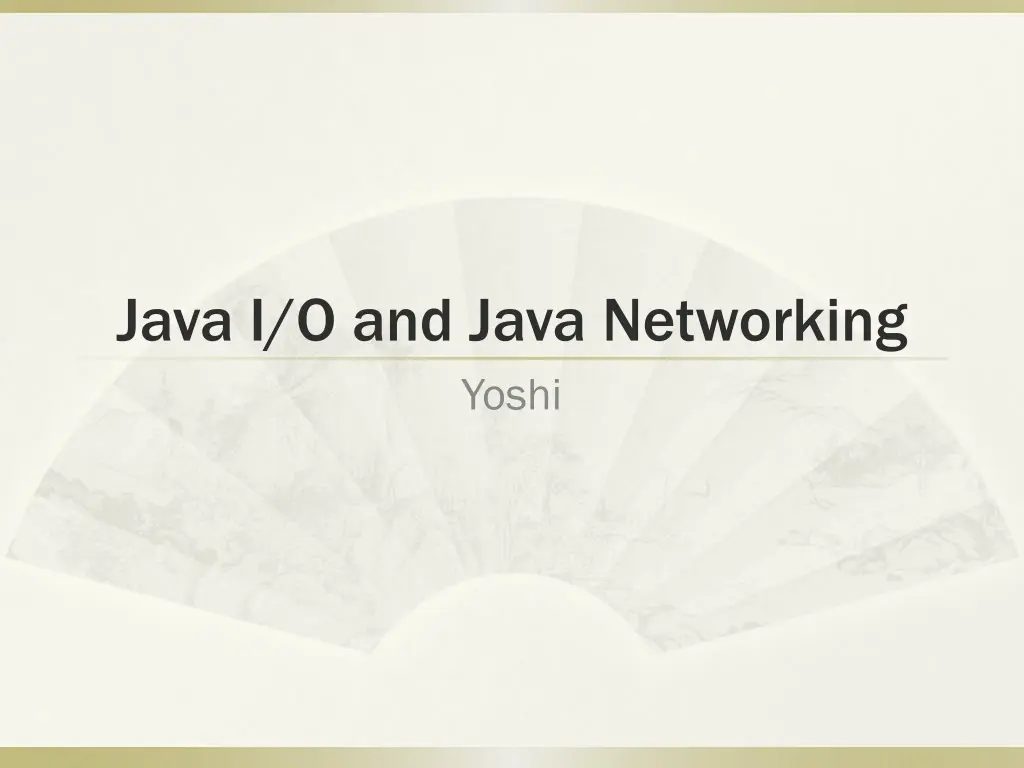
Understanding Java I/O Operations and Networking with Yoshi
Explore Java I/O operations and networking concepts with Yoshi in this tutorial. Learn about input/output streams, filters, character streams, sockets, and more to enhance your Java programming skills.
Download Presentation

Please find below an Image/Link to download the presentation.
The content on the website is provided AS IS for your information and personal use only. It may not be sold, licensed, or shared on other websites without obtaining consent from the author. If you encounter any issues during the download, it is possible that the publisher has removed the file from their server.
You are allowed to download the files provided on this website for personal or commercial use, subject to the condition that they are used lawfully. All files are the property of their respective owners.
The content on the website is provided AS IS for your information and personal use only. It may not be sold, licensed, or shared on other websites without obtaining consent from the author.
E N D
Presentation Transcript
Murmur ? ! Decorator pattern & other patterns ( ) Java I/O ( )
RTFSC Please see IOExample.zip Exercise Write your own input/output filters which encrypt/decrypt the stream data For example: a simple encryption I love you J mpwf zpv (shift 1) Write your own writer filter which makes to For example , ,
Stream Concept Input Stream Output Stream
Character Stream The Java platform stores character values using Unicode conventions. Character stream I/O automatically translates this internal format to and from the local character set. Character streams are often wrappers for byte streams. The character stream uses the byte stream to perform the physical I/O, while the character stream handles translation between characters and bytes. FileReader FileInputStream FileWriter FileOutputStream
Line-Oriented public class CopyLines { public static void main(String[] args) throws IOException { BufferedReader inputReader = null; PrintWriter outputWriter = null; try { inputReader = new BufferedReader(new FileReader( input.txt")); outputWriter = new PrintWriter(new FileWriter("output.txt")); String line; while ((line = inputReader.readLine()) != null) { outputWriter.println(line); } } finally { if (inputReader != null) { inputReader.close(); } if (outputWriter != null) { outputWriter.close(); } } } }
java.net.Socket This class implements client sockets (also called just "sockets"). A socket is an endpoint for communication between two machines. Very similar to local I/O operations
Retrieve Yahoo! Homepage import java.io.*; import java.net.*; public class RetrieveWeb { public RetrieveWeb(String host, int port) throws IOException { Socket socket = new Socket(host, port); InputStream in = socket.getInputStream(); BufferedReader reader = new BufferedReader( new InputStreamReader(in, "UTF8")); OutputStream out = socket.getOutputStream(); PrintWriter pw = new PrintWriter(new OutputStreamWriter(out)); pw.println("GET /"); pw.flush(); String line=""; while( (line=reader.readLine()) != null) { System.out.println(line);
Retrieve Yahoo! Homepage } reader.close(); pw.close(); } public static void main(String[] args) throws IOException { //delete the following three lines to make this program general args = new String[2]; args[0] = "tw.yahoo.com"; args[1] = "80"; int port = Integer.parseInt(args[1]); RetrieveWeb obj = new RetrieveWeb(args[0], port); } }
Something strange? java.io.InputStream public abstract int int read() throws IOException java.io.OutputStream public abstract void write(int IOException int b) throws
Something strange? (2) byte -128 ~ +127 -1 implies end of stream http://gaznjang.blogspot.com/2007/06/jav a-io-stream-read-write.html You can also find it in O Reilly Java I/O
Exercise Trace java.io.BufferedReader http://www.docjar.com/html/api/java/io/Buffer edReader.java.html Write a program to connect to hulabear.twbbs.org:23
